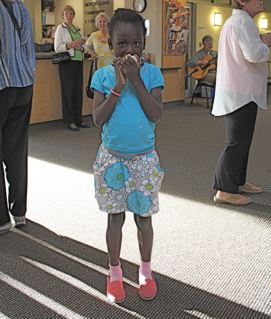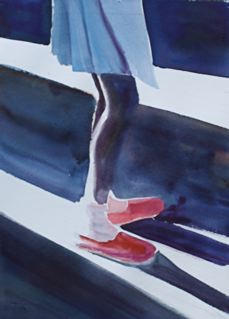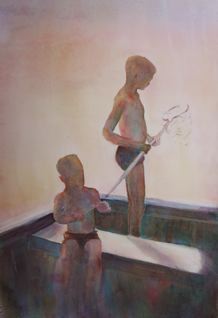We celebrate what occurs when painting plein air — the feel of the wind and sun on the skin, the smell of the flowers or the sea and how those find their way into the painting. The immediate response. The necessity to get it down and not overwork it. All good.
However, sometimes composition suffers. Sometimes the wind, the sun, the bugs, or the cows, the traffic become a distraction and we flee to our studios. There is a time for each.
As I write (1/22/16) a blizzard is burying the East Coast. Here on an island in the NW corner of the continental United States, it is 45 degrees with a soft rain falling outside my cozy studio. Holed up indoors we turn to our sketches, our quick paintings and our photographs. A good time for some guidelines.
 What do you choose?
What do you choose?
It is far better to use your own photos or unpublished photos of friends and family (with permission). Beware of using published photos, even those on the web. Most carry copyrights with them. Nor are they your creation. You may use them for generic help: what do dahlia leaves look like, or the head of a horse?
On the left is a photo from a newservice of the storm hitting Washington D.C. It is an excellent photo, a credit to the photographer. You may use it to practice drawing people walking, or to see how streetlights diffuse in a snowstorm. But don’t copy it for a painting. Create your own design.
How? Start by not choosing a photo that is too perfect, — even if it is yours. In fact, when you are photographing shoot AROUND the subject — several different photographs from different angles, different lighting. Leave the composing for later. Then put them all out when you …….
 Start drawing:
Start drawing:
I call this, “getting acquainted.”
You meet someone whom you would like to know. You manage to talk a little, look forward to another time to visit. Gradually you become acquainted. After more encounters you start becoming friends. Or not.
When you see a photo you think you would like to paint, start by making its acquaintance. Start drawing. Start from the shape you find most interesting and draw out from there.
What do you like about the photo? What is the idea that excites you? WHY do you want to paint this one? If it is too perfect, I suggest simply framing the photo. But if you have some ideas of what you would like to do with it, if you can use it as a starting point.
You will find there are things you like about the photo and things you throw out. Treat your first drawing (5″x 8″ or 8″ x 12″ ish) as simply shaking hands.
Do another. Focus on what you like, look for shapes that enhance it. Throw out clutter, anything that doesn’t contribute. Do several drawings trying one variation and then another. Once you get the shapes alighned in a pleasing manner, start looking at the value patterns.
 An example: here is a photo of a little girl at the NWWS opening a few years ago. I was sitting on a bench taking photos of feet and shadow patterns. She saw me and came to watch (!). Her pink shoes popped out against the stark black and white of the shadow patterns legs and black shoes of the others. I snapped a few of her. I couldn’t get the photos out of my head and later had to see if there was a painting here.
An example: here is a photo of a little girl at the NWWS opening a few years ago. I was sitting on a bench taking photos of feet and shadow patterns. She saw me and came to watch (!). Her pink shoes popped out against the stark black and white of the shadow patterns legs and black shoes of the others. I snapped a few of her. I couldn’t get the photos out of my head and later had to see if there was a painting here.

The Pink Shoes
In drawing, I became intrigued with the lost and found edges between the sun on her sock, on the backs of her legs and the floor, as well as with the lost edges between the shadow side of her legs and the floor — light against dark becoming dark against light. I did quite a few simple drawings — how much little girl? how long the shadow pattern.
When you are friends with your ideas having used the photos as inspiration, when you have worked out a plan that excites you, only then draw on you watercolor paper. Draw up your best value/shape drawing, keeping the porportions of the plan.
You may want a trial run. In the example I am using here, I first tried the composition vertically. It was more about the legs and shoes. I decided I wanted to emphasize the abstract pattern of the shadows and turned the next one to a horizontal format (see below).

Shadows at an Exhibition
I am currently working on two paintings both inspired by photographs. The first is the photo that starts this post, my two sons fishing at sunset on a lake in upper New York State a long time ago. The photo is fine as it is. I decided to use the backlit boys as the subject for a class I was teaching last winter.

![boysfishing[bw]](/wp-content/uploads/2016/04/boysfishingbw.jpg)
We were working on the proposition that “if you get the values right you can use any color you choose.” We worked from black and white value drawings, and black and white versions of our photos, trying to match the values but using wild or unusual colors. On the left is the one I did for the class. I felt I did get the colors the right values and liked how the variety of colors made the subject lighter and more fun. But I felt the boat became too important. I am trying it again, on a full sheet. … Will post it shortly. I hope.
 1/25/16… It is a bit gloomy outside but I just photographed the finished painting. Here it is again to the right. I called my husband (not the father of the boys) in to see it last night. His first reaction was what I wanted to hear… I like it! he said. It is two little boys in a boat fishing, he said. I don’t know why but I think the boat is tied up at the dock. It’s probably after supper in the summer. On a lake…
1/25/16… It is a bit gloomy outside but I just photographed the finished painting. Here it is again to the right. I called my husband (not the father of the boys) in to see it last night. His first reaction was what I wanted to hear… I like it! he said. It is two little boys in a boat fishing, he said. I don’t know why but I think the boat is tied up at the dock. It’s probably after supper in the summer. On a lake…
Memories. That is what it is about… Childhood memories. Time to stop on this one.
Time for you to get started.
Happy painting!
Caroline
